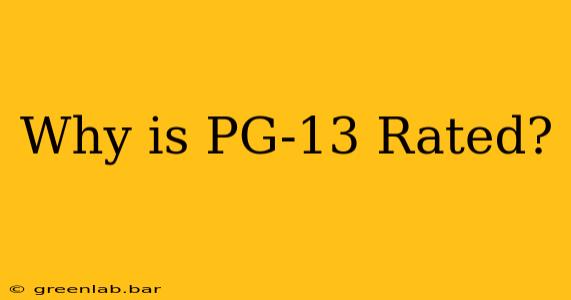The Motion Picture Association (MPA) rating system plays a crucial role in guiding parents' movie choices for their children. One of the most common ratings, and often a source of parental confusion, is PG-13. But why is a movie given a PG-13 rating? Let's delve into the specifics of this rating and what it signifies.
What Does PG-13 Mean?
PG-13 stands for "Parents Strongly Cautioned." This rating indicates that some material may be inappropriate for children under 13. While not explicitly prohibiting children under 13 from viewing, the MPA suggests that parents should be particularly discerning and consider the content before allowing younger viewers to watch. It's a warning, not a ban.
What Kind of Content Earns a PG-13 Rating?
A PG-13 rating usually encompasses a range of potentially objectionable content, including but not limited to:
- Suggestive Themes: This could include fleeting glimpses of sexuality or suggestive dialogue that may not be overtly explicit but still hints at adult themes. Think flirtatious interactions or innuendo.
- Mild Violence: Scenes of violence are permissible, but they generally lack graphic detail or excessive gore. Think of slapstick comedy violence or action sequences with minimal blood.
- Strong Language: While profanity might be present, it's usually infrequent and not overly offensive. Expect a few mild curse words or expletives, but not a constant barrage.
- Thematic Elements: The film's underlying themes or messages might deal with mature or complex subjects that might be unsuitable for very young children. This could include discussions of death, loss, or difficult life experiences.
The Difference Between PG-13 and Other Ratings
Understanding where PG-13 fits within the broader MPA rating system helps clarify its meaning:
- PG (Parental Guidance Suggested): Similar to PG-13, but generally containing less mature content. Parents are advised to consider the suitability of the movie for their children.
- R (Restricted): Contains adult material that's inappropriate for children under 17. These films typically have more explicit violence, sexuality, language, and/or drug use.
- NC-17 (No One 17 and Under Admitted): The strictest rating; this content is considered unsuitable for anyone under 17 and contains highly explicit material.
Why is Consistency Important?
While the application of the PG-13 rating can sometimes seem subjective, the MPA aims for consistency in its guidelines. A panel of parents reviews films and makes the final rating decision. The goal is to provide parents with a reliable indicator of a movie's suitability for their children.
Parental Responsibility Remains Key
Ultimately, the PG-13 rating serves as a guideline. Parents are still responsible for making informed decisions about what their children watch. Previewing trailers, reading reviews, and checking the specific content descriptors offered by the MPA can further assist in this process. The rating system is a tool to aid parents, not replace their judgment.
Conclusion: Navigating the PG-13 Landscape
Understanding the nuances of the PG-13 rating allows parents to make more informed choices regarding their children's movie viewing habits. By understanding what constitutes a PG-13 movie, parents can more effectively assess the appropriateness of the content and make the best decisions for their families. Remember, the rating is a suggestion – parental involvement and discretion remain crucial.

